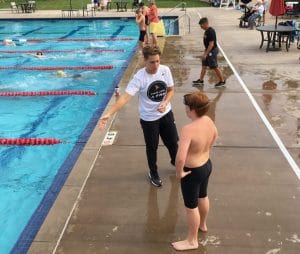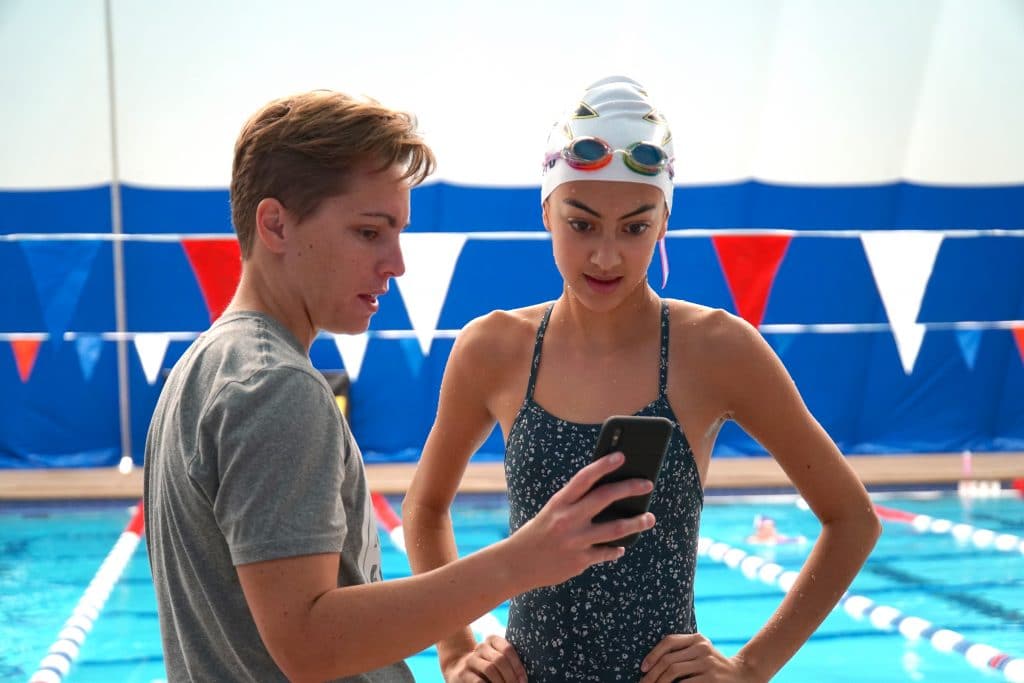The Crossover Turn has made strides in the last decade of being the ‘Fastest Turn’ out there for the Backstroke to Breaststroke transition. The funny part is this type of turn was actually a progression from the many different styles of Backstroke Flipturns dated back to the 1970’s. Little did I know the rabbit hole I was about to go down about this turn. A big thanks to a few people that commented on my “Bucket Turn” video enlightening me that there was really actually more than one Bucket Turn!
Let’s get started!
When I grew up swimming (in the 90’s), I was taught the Bucket (or Suicide) turn for my Back to Breaststroke transitions. This turn is essentially the one where you hit the wall and go into a backflip – before pushing back off.
Suicide Turn Example:
When I uploaded this video to Instagram, I actually got quite the backlash from some older coaches and swimmers who were taught a Bucket Turn for a Backstroke Flipturn in the earlier years. Me – having no idea – that type of turn existed in Backstroke, immediately googled that turn and the portal to the rabbit hole opened. It makes so much more sense to me now why the verbiage for the post was confusing, so for ease in our new series – I will be referring to my regular Bucket Turn as a Suicide Turn.
Obviously now, we see a lot less of the Suicide Turn. One of the main reasons the Suicide Turn isn’t taught anymore is because the amount of time it requires swimmers to hold their breath. With the newer and more improved Crossover Turns, swimmers still get the benefit of a flip, BUT they don’t have to hold their breath for as long – going straight into their pullout.
Let’s WORK together!

Swim Like A. Fish now offers virtual coaching packages for swimmers — no matter where you are in the world. We keep our list of athletes short to make sure we are getting you what YOU need.
Crossover Turn History:
As I said above, the cool part about the Crossover Turn is it’s NOT new! You can actually see in this video from the Finals of the 200 Backstroke in the 1972 Olympics Games – both the Suicide Turn and Crossover Turn’s were present, but for a different transition:
Obviously the rules for Backstroke turns have changed since then – stating – you don’t have to touch the wall with your hand, before transitioning to a new lap – so now we have moved away from these turn styles to the regular Backstroke Flipturn.
Why are there so many Crossover Turn Variations?
My honest answer: I think it’s a really hard turn to teach and not many coaches know how the turn actually works, technically. I’ve been teaching more of the Backstroke Flipturn (with a hand touch at the wall), but I quickly realized my swimmers created multiple versions of the same turn – with the same teaching. It took me auditing my group and realizing – depending on the turn style, I may see some of my swimmer’s arms, heads, legs – or any variation of the three outside the water during their interpretation of the Crossover Turn! So further down the rabbit hole I went!
The 3 Crossover Turn Styles:
1.) The Backstroke Flipturn Modification:
As I stated above this is the type of turn I’ve been teaching this type the most. This was actually the style I was taught during the end of my swimming career and physically, made the most sense for my body to do.
To perform this type of turn, you have swimmers come into the wall – hitting the wall with their top arm and crossing it over their body. The goal is to have a deep touch on the wall with their hips still angling up, so technically they’re still on their back. From there, swimmers get their final change for air before they roll AWAY from their open armpit to their stomach and push off.
Backstroke Flipturn Example:
2.) The Bottom Arm Spin Turn
The second style of Crossover Turn is one of two types of spin turns – the main difference being the hand that touches the wall. On this specific type of turn, swimmers come into the wall like they’re finishing a Backstroke race and hit the wall with their bottom arm. From there, they spin their feet back towards the wall, while bringing their knees into their chest. It’s literally a sideways flipturn to which then they push off. This type of Back to Breast turn is often referred to as a ‘Touch & Go’ turn as well!
This type of Crossover Turn you see the most parts of a swimmer’s body outside the water. Because it’s the bottom arm that hits the wall, which causes a swimmer’s head comes up above the surface – along with their arm and knees during the spin.
Bottom Arm Spin Turn Example:
3.) The Top Arm Spin Turn
A while back, Chloe Sutton, was making some YouTube tutorials for Swimmer’s and I came across her Crossover Turn video. I noticed it was similar to my Backstroke Flipturn style of Crossover Turn, but what the body did appear to be different. Well, that’s because this turn is actually a blend of the first two, where swimmers hits the wall with their top arm (instead of their bottom), and then performs the same spinning motion as Bottom Arm Spin Turn to get off the wall.
For this type of turn, you see little to none of the body come up compared to the Bottom Arm version of it. It’s very obvious how deep the body stays below the water in the video below.
Top Arm Spin Turn Example:
So which one is right? Well it’s up for debate. Be sure to stay tuned for Part II of this series where we discuss the Pros/Cons of each of these Crossover Turn Styles!
Free Stroke Analysis!

For a limited time ONLY, Swim Like A. Fish is offering each swimmer or coach 1 FREE Stroke Analysis. We KNOW times are tough right now, but let’s keep the morale high! Redeem your FREE analysis below:
No lies, I’m pretty proud of myself for this one.
Until Next Time,
Abbie Fish

3 Responses
thanks 🌹🌹🌹
Excellent